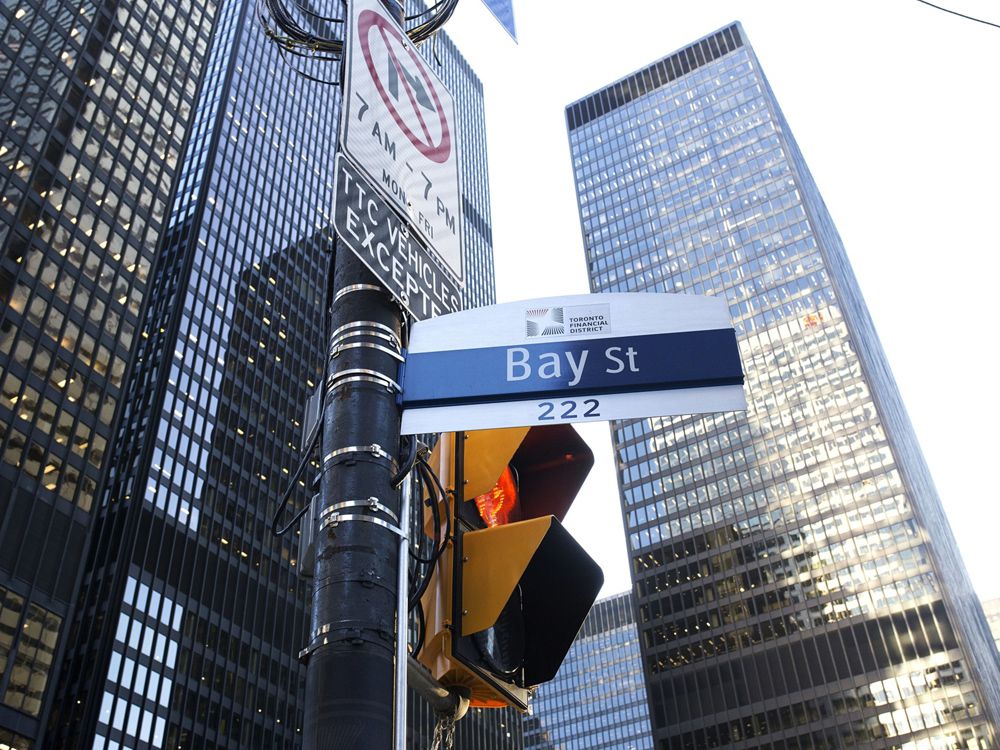Some analysts expect the move to point to a much more aggressive rate hike path for the rest of the year
A ‘Bay Street’ sign in the financial district of Toronto. Photo by Stephanie Foden/Bloomberg files The Bank of Canada pushed ahead with its first 50-basis point interest rate hike in 22 years on Wednesday, a move that came as no surprise to economists and bank watchers who had widely anticipated the increase. What comes next, however, is less certain.
Advertisement 2 This advertisement has not loaded yet, but your article continues below.
Economist Royce Mendes from Desjardins Group saw the aggressive move — which included announcing that the central bank would begin quantitative tightening, or reducing the amount of government bonds held on its balance sheet, effective April 25 — as an acknowledgement of the need to move “forcefully” to combat rising prices and return rates to more neutral levels.
The central bank’s super-sized rate hike came as inflation roared to 5.7 per cent in February, according to consumer price index readings.
In addition to raising the overnight rate to one per cent, the bank also increased its projection for GDP growth to 4.2 per cent this year, from the initial four per cent laid out in its January monetary policy report, and bumped up inflation expectations to a 5.3 per cent average from 4.2 per cent.
Advertisement 3 This advertisement has not loaded yet, but your article continues below.
“These revisions come as little surprise given all that’s transpired since the previous estimates were released in January,” Mendes wrote.
“Notably, however, the Bank of Canada is more optimistic on growth in 2023 than us, as we see rate hikes biting earlier and more acutely.”
Desjardins sees room for further tightening into next year, but did not think the Bank of Canada would keep pace with the U.S. Federal Reserve, which is expected to take rates above three per cent.
Paul Ashworth, chief North America economist at London-based research firm Capital Economics, shared the view that Canada’s rate hike path would lag the U.S. going forward.
In a note Wednesday morning, Ashworth argued that housing vulnerabilities would keep the Canadian central bank’s hands tied, and that it would likely struggle to get the policy rate much higher than the two per cent mark. The Fed, by comparison, is expected to bring the Fed Funds Rate to a peak of 3.38 per cent.
Advertisement 4 This advertisement has not loaded yet, but your article continues below.
“Since housing is more obviously over-valued north of the border, household debt burdens are much higher and rate-sensitive residential investment accounts for a much bigger share of the economy,” Ashworth wrote.
The pressure that climbing rates are expected to put on housing and mortgage debt holders will be closely watched in the months ahead. James Laird, co-founder of Ratehub.ca, said in an e-mail that home owners will feel the pinch with each rate hike throughout the year.
“Canadians with variable-rate mortgages and home equity lines of credit (HELOCs) will feel an immediate impact and can expect their lenders to increase their prime lending rates by 50 basis points in the coming days,” Laird said. “This group should budget for further rate increases throughout this year.”
Advertisement 5 This advertisement has not loaded yet, but your article continues below.
More On This Topic Kevin Carmichael: Brace for more big hikes because Bank of Canada is far from finished Bank of Canada hikes interest rate by 0.5% for first time in 22 years Canadian banks go on a hiring spree, defying tight labour market and surging inflation Depending on how aggressive the Bank of Canada gets with its path of rate increases, mortgage holders can expect more pressure down the line. Bank of Montreal chief economist Douglas Porter noted that the central bank updated its estimates for neutral interest rates from a range of 1.75-2.75 per cent to a range of two-to-three per cent.
“We believe that the Bank will get the policy rate to at least the low end of that (updated) range as quickly as reasonably possible, before then shifting to a meeting-by-meeting game-time decision — which we believe will be a series of 25 basis point hikes on alternate meetings, until they get to the higher end of the neutral range.”
This advertisement has not loaded yet, but your article continues below.
Article content In response to the bank’s actions Wednesday, BMO said it was raising its interest rate forecast by 25 basis points for the year.
It is now looking for 50-point hikes in June and July to quickly bring the overnight to two per cent, and an additional 25-point hike that would see a rate of 2.25 per cent by the end of the year.
Analysts at LowestRates.ca expect the move from the Bank of Canada today could point to a much more aggressive rate hike path for the rest of the year.
“Rates are going up this year, but we do not know what next year will bring. This creates a bit of a roller coaster experience for current and would-be homeowners,” Leah Zlatkin, LowestRates.ca’s licensed mortgage broker, said in an e-mail.
“These increased costs have a real impact on homeowners’ wallets,” Zlatkin added. “Some variable-rate holders may think about switching to a fixed rate to bring some stability to their outlook, but anyone with variable rate will still be saving money over a fixed rate right now.”
• Email: shughes@postmedia.com | Twitter: StephHughes95
Financial Post Top Stories Sign up to receive the daily top stories from the Financial Post, a division of Postmedia Network Inc.
By clicking on the sign up button you consent to receive the above newsletter from Postmedia Network Inc. You may unsubscribe any time by clicking on the unsubscribe link at the bottom of our emails. Postmedia Network Inc. | 365 Bloor Street East, Toronto, Ontario, M4W 3L4 | 416-383-2300
